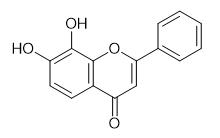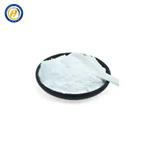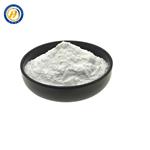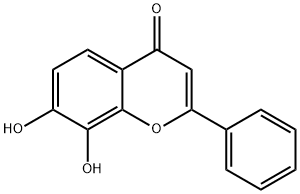Synthesis and Bioactivity of 7, 8-Dihydroxyflavone
General description
7, 8-Dihydroxyflavone (7,8-DHF) is a white crystalline powder soluble in organic solvents such as methanol, ethanol, and DMSO, derived from the dried root of Pulsatilla chinensis (Bge.) Regel. It is a potent and selective TrkB receptor agonist (Kd≈320 nM). TrkB receptor is the main signaling receptor for brain-derived neurotrophic factor.

Fig. 1 The structure of 7,8-Dihydroxyflavone
Synthetic routes
Fig. 2 The synthetic step 1 of 7,8-Dihydroxyflavone.
Dissolve Rh(l-phe)(cod) (1.50 mg, 3.98 × 10-6mol), 1,2,3,4-tetraphenyl-1,3-cyclopentadiene (7.04 mg, 1.90 × 10-5mol) and Cu(OAc)2·H2O (200mg, 1.00 × 10-3 mol) in o-xylene (2.76 mL, 2.29 × 10-5 mol). Add substituted 2,4-dihydroxybenzaldehyde (6.04 × 102 mg, 4.37 × 10-3 mol) and phenylacetylene (4.91 × 10-1 mL, 4.47 × 10-3 mol) to the mixture. Stir the mixture under N2 at 120 °C for 6 hours. Extract the product by ether and water. Isolate the product in n-hexane and ethyl acetate by silica gel column chromatography. 1H NMR (600 MHz, CDCl3, TMS, δ): 7.54 (d, 2H, H-2, H-5, J = 2.4Hz), 7.53 (d, 1H, H-6, J = 3.6Hz), 7.39 (t, 1H, H=4', J = 3Hz), 7.38 (t, 1H, H-5', J = 6Hz), 7.37 (t, 1H, H-3', J = 3Hz), 7.35 (s, 1H, H-1'), 7.34 (d, 1H, H- 2', J = 1.2Hz), 7.33 (t, 1H, H-4', J = 3.6Hz). 13C NMR (150 MHz, CDCl3, TMS, δ): 73.91, 81.56, 121.82, 128.45, 129.22, 132.52 ppm. IR (KBr): 3064, 2973, 2918, 2198, 1961, 1487, 1460, 1013 cm-1 [1].

Fig. 3 The synthetic step 2 of 7,8-Dihydroxyflavone.
Dissolve the 7,8-dimethoxy-2-phenyl-4H-chomen-4-one (0.050 g, 0.178 mmol) in anhydrous DCM (0.6 mL). Add BBr3 (1.25 eq) to the mixture. Stir the reaction at room temperature for 4 hours. Dilute the reaction mixture with water (1 mL). Adjust the pH to 6 with 5% NaH2PO4. Extract the aqueous layer with EtOAc (2 x 2.5 mL). Combine the organic layers. Dry the organic layers over anhydrous MgSO4. Concentrate the organic layers in vacuo. Purify the residue by column chromatography with EtOAc (100%) to obtain 7,8-dihydroxy-2-phenyl-4H-chomen-4-one. 1H NMR (DMSO-d6, 400 MHz) δ 6.88 (1H, s, H-3), 6.95 (1H, d, J = 9.0 Hz, H-6), 7.39 (1H, d, J = 9.0 Hz, H-5 ), 7.55-7.58 (3H, m, H-3',4',5'), 8.14 (2H, dd, J = 5.0, 4 Hz, H-2',6'), 9.52 (1H, s, OH), 10.32 (1H, s, OH). 13C NMR (DMSO-d6, 100 MHz) δ 105.99 (C3), 114.01 (C6), 115.08 (C9), 116.90 (C5), 126.30 (C2', C4', C6'), 128.97 (C3', C5'), 131.45 (C1'), 133.06 (C8), 146.67 (C10), 150.52 (C7), 161.68 (C2), 176.86 (C=O) IR νmax [cm-1 ]: 1699 (C=O, ν, s), 1194 (C-O, ν, m), 3164 (OH, w, b). Mass Spec (FTMS+ESI): M+H (C15H11O4) requires 255.0652, found 255.0652 [2].

Fig. 4 The synthetic step 3 of 7,8-Dihydroxyflavone.
Add benzoyl chloride (3.3 mmol) dropwise to the solution of 1,2,3-trihydroxyacetophenone (1 mmol) and K2CO3 (8 mmol) in acetone for10 minutes. Reflux the resulting reaction mixture for 12 hours. Evaporate the acetone. Add 250 ml of MeOH/H2O (1:1) to the mixture. Reflux the solution for 3 hours. Cool the solution to room temperature. Pour the solution into crushed ice. Acidify the solution with 2 N HCl. Filter the precipitate. Dry the precipitate. Recrystallize the product in MeOH [3].
Bioactivity
Antidepressant
Objective Brain-derived neurotrophic factor (BDNF) and its specific receptor, tropomyosin-related kinase (TrkB), play important roles in treating depression. In this experiment, we examined whether 7,8-dihydroxyflavone, a novel potent TrkB agonist, could reverse the behavioral and biochemical abnormalities induced by the chronic mild stress (CMS) paradigm in rats. Methods SD rats were exposed to a battery of stressors for 56 days. 7,8-dihydroxyflavone (5 and 20 mg/kg) were administered intraperitoneally during the last 28 days of the CMS paradigm. Rats were tested in sucrose consumption test (SCT), forced-swimming test (FST) and elevated T-maze (ETM). Serum corticosterone levels and hippocampal BDNF levels of the rats were measured. Results Four-week CMS on the rats induced their depression-like behavior in SCT. The CMS-reduced sucrose consumption was reversed starting from 7 days after the 7,8-dihydroxyflavone (20 mg/kg) treatment and remained across the subsequent treatment regime. 7,8-dihydroxyflavone, when given at 5 mg/kg for 3 weeks, reduced the immobility time in the FST in the CMS-subjected rats. Additionally, the 4-week treatment with 7,8-dihydroxyflavone (20 mg/kg) attenuated the CMS-induced increase in anxiety-like behavior in the ETM. For the CMS-subjected rats, 7,8-dihydroxyflavone treatment dose-dependently reduced their serum corticosterone levels but increased their hippocampal BDNF levels only at 5 mg/kg. Conclusion 7,8-dihydroxyflavone was beneficial for both depression and anxiety-like behaviors, and may exert fast-onset antidepressant effects. This provides a new insight into the pharmacological management of depression [4].
Brain-derived neurotrophic factor (BDNF) modulates the synaptic transmission of several monoaminergic neuronal systems. Molecular techniques using synapatosomes in previous studies have suggested that BDNF's receptor, tyrosine kinases (Trk), can quickly regulate dopamine release and transporter dynamics. Our main objective in this study is to determine whether slice fast scan cyclic voltammetry can be used to investigate the role of the TrkB receptor on dopamine release and uptake processes in the caudate-putamen. Fast scan cyclic voltammetry measured dopamine release and uptake rates in the presence of BDNF, or its agonist 7,8-dihydroxyflavone, or a TrkB inhibitor K252a. Superfusion of BDNF led to partial recovery of the electrically stimulated dopamine release response in BDNF+/- mice which is blunted compared to wildtype mice, with no effect in wildtype mice. Conversely, infusion of 7,8-dihydroxyflavone increased electrically stimulated dopamine release in wildtype mice with no difference in BDNF+/- mice. Overall, BDNF and 7,8-dihydroxyflavone had no effect on dopamine uptake rates. Concentrations greater than 3 mu M 7,8-dihydroxyflavone affected dopamine uptake rates in BDNF+/- mice only. To demonstrate that BDNF and 7,8-dihydroxyflavone modulate dopamine release by activating the TrkB receptor, both genotypes were pretreated with K252a. K252a was able to block BDNF and 7,8-DHF induced increases during stimulated dopamine release in BDNF+/- and wildtype mice, respectively. Fast scan cyclic voltammetry demonstrates that acute TrkB activation potentiates dopamine release in both genotypes [5].
Neuroprotective
Objective: To investigate the protective effect of the specific tyrosine receptor kinase B (TrkB) agonist 7,8-dihydroxyflavone in spinal cord injury and the involved mechanisms. Methods: A total of 130 male ICR mice were randomly div);
You may like
See also
Lastest Price from 7,8-Dihydroxyflavone manufacturers

US $0.00-0.00/kg2024-05-17
- CAS:
- 38183-03-8
- Min. Order:
- 1kg
- Purity:
- 99%
- Supply Ability:
- 500

US $0.00-0.00/kg2024-05-17
- CAS:
- 38183-03-8
- Min. Order:
- 1kg
- Purity:
- 99%
- Supply Ability:
- 500



